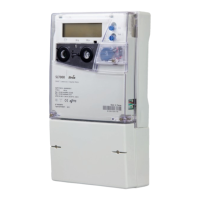The following example illustrates five daily profiles with seven switching-times:
Profile TS1 TS2 TS3 TS4 TS5 TS6 TS7
DP1 00:00 [3] 06:00 [2] 09:00 [1] 11:00 [2] 18:00 [1] 20:00 [2] 20:00 [3]
DP2 00:00 [3] 06:00 [2] 22:00 [3]
DP3 00:00 [5] 06:00 [4] 22:00 [5]
DP4 00:00 [3]
DP5 00:00 [5]
Note: The numbers in enclosed brackets, e.g. [3], show the associated index.
6.7.5. Indexes
The contractually specified tariffs define the energy and demand rates being used by the meter. However, in
many cases, active energy has more rates defined (for billing purposes) than reactive energy.
An index describes a combination of energy and demand rates that are activated simultaneously.
The meter index structure provides a mechanism to manage:
• up to fifty different rate switching schemes for active and reactive energy
• any overlapping rates for demand
• the activation of any assigned control outputs
Note: The energy (page 39) and demand (page 42) channels must already be defined in the meter before
indexes can be configured and the required control outputs must be assigned to index use.
6.7.5.1. Index activation
Indexes can be activated as follows:
• Immediately
The rate change is applied immediately as defined in the calendar day profile.
• Delayed
The rate change is delayed until the end of any running demand calculation integration period (page 42).
• Clock Loss
When a clock loss event is detected (backup power supply (page 34) sources exhausted), the meter will
switch to a pre-configured index with a low tariff rate to ensure the customer is not penalised during this
period.

